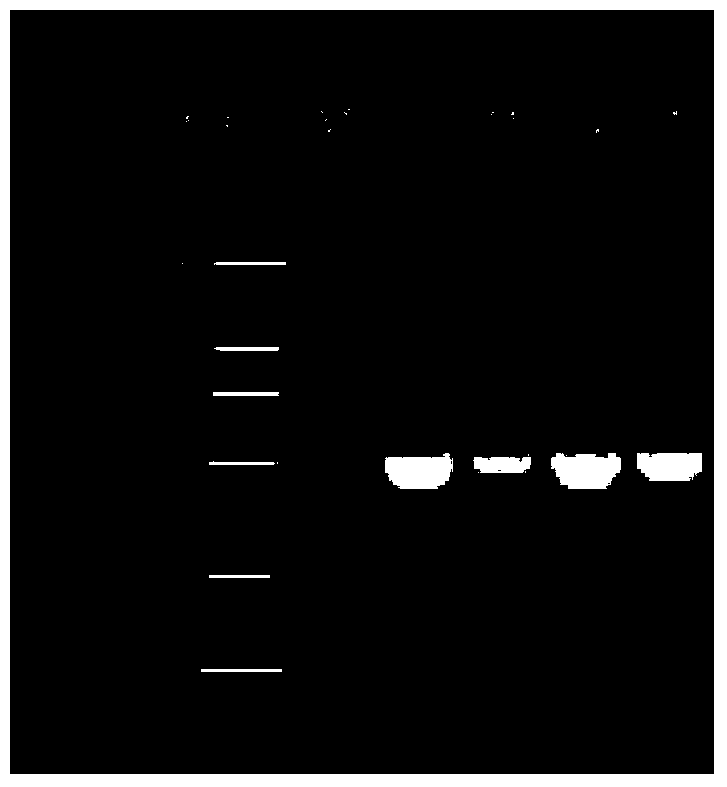Molecular identification method for lasiohelea taiwana
A midge and gene technology is applied in the field of molecular identification of midges in Taiwan to achieve the effect of shortening identification time and accurate identification
- Summary
- Abstract
- Description
- Claims
- Application Information
AI Technical Summary
Problems solved by technology
Method used
Image
Examples
Embodiment 1
[0043] Example 1 Acquisition of the COI gene sequence of the midges in Taiwan.
[0044] 1. Acquisition of Taiwan midge specimens
[0045] Formosan midges bred in batches in the laboratory were killed by freezing and stored in 95% ethanol directly. The species of Taiwan midges have been reviewed by authoritative experts before batch breeding.
[0046] 2. DNA template preparation
[0047] Using the micro-DNA template preparation method of small insects to extract the DNA of midges in Taiwan (Editor-in-Chief Wen Lizhang. Introduction to Entomological Research Methods and Techniques [M]. Beijing: Science Press, 2010.278-286), the extracted DNA samples were stored at -20°C spare.
[0048] 3. Primer synthesis
[0049] The primers used in this example are as follows:
[0050] Forward primer 5’GGT CAA CAA ATC ATA AAG ATA TTG G 3’
[0051] Reverse Primer 5’TAA ACT TCA GGG TGA CCA AAA AAT CA 3’
[0052] 4. PCR amplification
[0053] The PCR reaction system of this embod...
Embodiment 2
[0064] Example 2 Acquisition of the ITS2 Gene Sequence of the Formosan midge
[0065] 1. Primer synthesis
[0066] With the Taiwan midge DNA obtained in Example 1 as a template, primers were synthesized, and the primer sequences used were as follows:
[0067] Forward primer 5'GATGAAGACCGCAGCAAACT 3'
[0068] Reverse primer 5'ATTTGGGGGTAGTCACACAT 3'
[0069] 2. PCR amplification
[0070] The PCR reaction system of this embodiment is shown in Table 3.
[0071] Table 3 The PCR reaction system of the ITS 2 gene of the Taiwan midge midge (take 50uL as an example)
[0072]
[0073] The reaction procedure of this embodiment is shown in Table 4.
[0074] Table 4 PCR reaction program of ITS 2 gene of the midges in Taiwan
[0075]
[0076] 3. PCR amplification product detection
[0077] Take 5 μL of the PCR amplification product and electrophoresis with 1% agarose gel (130V voltage, electrophoresis for 35 min). Ethidium bromide staining, gel imaging system detection, e...
Embodiment 3
[0080] Example 3 Identification of unknown midges
[0081] 1. Collection and preservation of specimens
[0082] The collected specimens were collected by waving nets or human inducement, and the collected specimens were killed by freezing and stored in 95% ethanol directly.
[0083] 2. DNA template preparation
[0084] Under a dissecting mirror or a stereo microscope, a female midge was randomly selected from the collected midge specimens, and the DNA of the midge was extracted by using the small-scale insect DNA template preparation method (Wen Lizhang, editor-in-chief. Entomological research methods and techniques Introduction [M]. Beijing: Science Press, 2010.278-286), the extracted DNA samples were stored at -20°C for future use.
[0085] 3. Acquisition of target gene sequence
[0086] 3.1 COI gene
[0087] 3.1.1 Primer synthesis
[0088] The obtained unknown midge DNA is used as a template to synthesize primers, and the primer sequences used are as follows:
[0089]...
PUM
 Login to View More
Login to View More Abstract
Description
Claims
Application Information
 Login to View More
Login to View More - R&D
- Intellectual Property
- Life Sciences
- Materials
- Tech Scout
- Unparalleled Data Quality
- Higher Quality Content
- 60% Fewer Hallucinations
Browse by: Latest US Patents, China's latest patents, Technical Efficacy Thesaurus, Application Domain, Technology Topic, Popular Technical Reports.
© 2025 PatSnap. All rights reserved.Legal|Privacy policy|Modern Slavery Act Transparency Statement|Sitemap|About US| Contact US: help@patsnap.com



